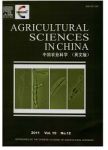iTRAQ-based quantitative proteomics analysis of defense responses triggered by the pathogen Rhizoctonia solani infection in rice
防卫回答的基于 iTRAQ 的量的 proteomics 分析在米饭由病原体 Rhizoctonia solani 感染被触发作者机构:Key Laboratory of Plant Functional Genomics of the Ministry of Education/Jiangsu Key Laboratory of Crop Genomics and Molecular BreedingAgricultural CollegeYangzhou UniversityYangzhou 225009P.R.China Co-Innovation Center for Modern Production Technology of Grain Crops of Jiangsu Province/Key Laboratory of Crop Genetics and Physiology of Jiangsu ProvinceYangzhou UniversityYangzhou 225009P.R.China Joint International Research Laboratory of Agriculture and Agri-Product SafetyMinistry of Education of China/Institutes of Agricultural Science and Technology DevelopmentYangzhou UniversityYangzhou 225009P.R.China Yangzhou Polytechnic CollegeYangzhou 225000P.R.China Jiangsu Hongqi Seed Stock Co.Ltd.Taizhou 225311P.R.China
出 版 物:《Journal of Integrative Agriculture》 (农业科学学报(英文版))
年 卷 期:2022年第21卷第1期
页 面:139-152页
核心收录:
学科分类:09[农学] 0904[农学-植物保护] 090401[农学-植物病理学] 090402[农学-农业昆虫与害虫防治]
基 金:financially supported by grants from the National Key Research and Development Program of China(2016YFD0100601) the National Natural Science Foundation of China(31701057 and 31672013) the Natural Science Foundation of Jiangsu Province,China(BK20170487) the Fok Ying Tung Education Foundation,China(151026) the China Postdoctoral Science Foundation(2017M620227) a project funded by the Priority Academic Program Development of Jiangsu Higher Education Institutions,China(PAPD) the Natural Science Foundation of the Jiangsu Higher Education Institutions of China(19KJD210001) 2018 Annual Key Project of Scientific Research in Yangzhou Polytechnic College,China(2018ZR07)
主 题:rice sheath blight Rhizoctonia solani proteomic defense response
摘 要:The soil-borne necrotrophic fungus Rhizoctonia solani is one of destructive fungi causing severe yield losses in various important crops. However, the host defense mechanisms against the invasion of this pathogen are poorly understood. In this study, we employed an i TRAQ-based quantitative proteomic approach to investigate host proteins responsive to R. solani using the resistant rice cultivar YSBR1. As a whole, we identified 319 differentially accumulated proteins(DAPs) after inoculation of rice plants with R. solani. Functional categorization analysis indicates that these DAPs cover a broad range of functions. Notably, a substantial portion of the DAPs are involved in cell redox homeostasis, carbohydrate metabolism, and phenylpropanoid biosynthesis, or belong to pathogenesis-related proteins, indicating that these processes/proteins play important roles in host defense against R. solani. Interestingly, all of the DAPs involved in photosynthesis and chlorophyll biosynthetic processes, and part of the DAPs involved in phenylpropanoid biosynthesis, show reduced accumulation after R. solani infection, suggesting that R. solani probably inhibits host photosynthetic system and phenylpropanoid biosynthesis to facilitate infection and colonization. In conclusion, our results provide both valuable resources and new insights into the molecular mechanisms underlying rice and R. solani interaction.



